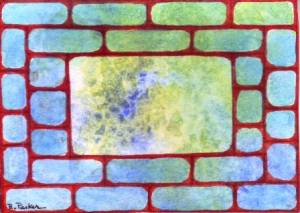– George Sand
(Cool note: George Sand was a woman!)

Hope
2.5″ x 3.5″ Watercolor
In my window series, I call this one Hope because it’s a window with a clear view of whatever fantasy the mind might conjure up. There is nothing predefined. I did the watercolor, salt saran wrap treatment to the watercolor paper, before I painted the stained glass type window on it. It’s from the same piece of paper I did the stone window on.
I had my second flying lesson last night. It was so cool! My CFI (certified flight instructor) is wonderful! He really is perfect for me. He wants me to have fun and be at ease. He doesn’t want me to miss a thing. With his help, I am beginning to gain a little more confidence. I am having the time of my life!
George Sand
The French novelist George Sand (1804-1876) was the most successful woman writer of her century. Her novels present a large fresco of romantic sentiment and 19th-century life, especially in its more pastoral aspects.George Sand was born Armandine Aurore Lucille Dupin in Paris on July 1, 1804. On her father’s side she was related to a line of kings and to the Maréchal de Saxe; her mother was the daughter of a professional bird fancier. Aurore’s father, Maurice Dupin, was a soldier of the Empire. He died when Aurore was still a child.
At the age of 14, tired of being the “apple of discord” between her mother and grandmother, Aurore went to the convent of the Dames Augustines Anglaises in Paris. Though she did her best to disrupt the convent’s peaceful life, she felt drawn to quiet contemplation and direct communication with God.
To save Aurore from mysticism, her grandmother called her to her home in Nohant. Here Aurore studied nature, practiced medicine on the peasants, read from the philosophers of all ages, and developed a passion for the works of François René Chateaubriand. Her eccentric tutor encouraged her to wear men’s clothing while horseback riding, and she galloped through the countryside in trousers and loose shirt, free, wild, and in love with nature.
Read more about her here.




No comments:
Post a Comment